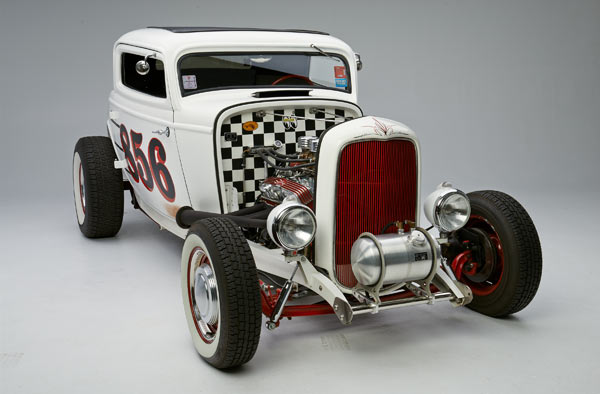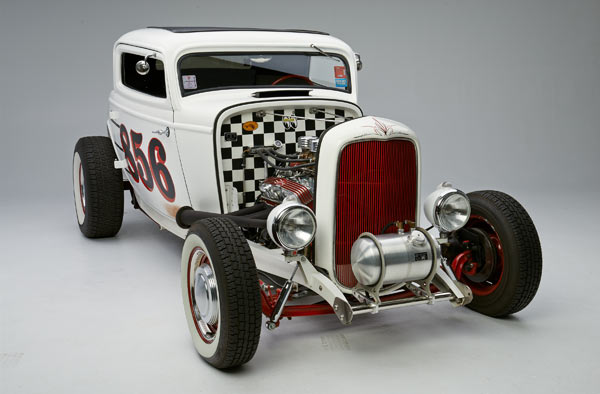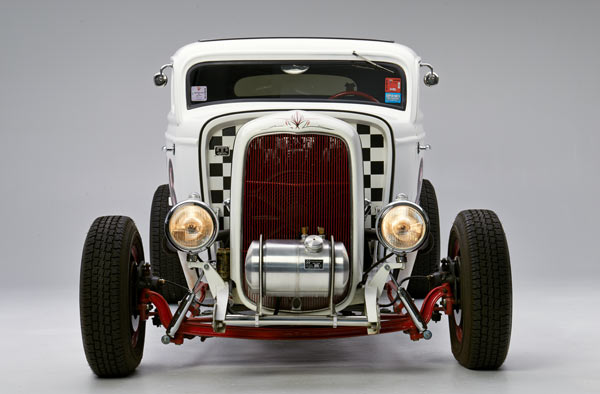Chess is a game of strategy—you start with a board full of pieces and hope to still have your king by the end of play. When Dave Madej jumped back into the hot rod game, he cleared the board and ended up with one royal ride: this outstanding 1932 Ford Coupe.
The Deuce is fast, loud, and to be honest, a little uncomfortable on those long runs, and that’s just the way Madej likes it.
Hardly a hot-rod rookie, Madej spent his early childhood chasing his father around Cleveland’s Cloverleaf Speedway.
“My dad’s friend raced a ’57 Chevy and we’d give him a hand at the track,” Madej said. By the age of 14, he wanted his own car.
“I paid sixty bucks for a 1960 Chevy that burned a little oil. Back then you could buy bulk oil right at the gas pump. I think that car used about a gallon of oil every week,” Madej said.
The youngster restored the car’s ragged exterior and gave it a fresh coat of paint before moving on to his next ride, a 1956 Chevy. “I know everyone wants a Tri-5, but I bought it because it was only $25. The transmission was blown so I drove it home 15 miles in the only gear that worked, which was reverse,” he said.
As the years went by, Madej cycled through a series of sweet muscle cars followed by a 1932 Graham-Paige sedan.
“The sedan took nine years to build. My family and I enjoyed that car, but a guy wanted to buy it, and by then I really wanted to build a ’32 Ford coupe,” he said. “In the hot rod world a ’32 Ford is it, so I had to let the sedan go.”
With an empty garage, Madej was ready to collect the pieces that would become his dream Deuce. His first move was an important one—the build had to have a solid foundation.
“The stock Ford frame can’t stand up to big horsepower,” he said. “Luckily, my buddy told me about Barry Lobeck, who was building boxed and reinforced ’32 frames.”
Madej hooked up his trailer and paid a visit to a fellow who had a Lobeck frame for sale in Medina, OH. He liked what he saw and came home with a rolling chassis complete with a Super Bell I-beam front suspension and 4-link coil-over setup in the back.
To top off the beefy frame, Madej ordered a fiberglass 3-window coupe body with a two-inch chop from Florida.
“When it comes to ’32 Fords, three-windows have more interior room than five-window coupes or convertibles, and I need all of the space I can get,” said Madej who is 6’4”.
He would have to wait four months for the body, and that gave him plenty of time to formulate a game plan for the wiring harness, hydraulic lines, and drivetrain.
“I mocked up all of the systems first. I tried to think three moves ahead, so if something broke after the car was finished it would be easy to repair,” he said.
Eventually, the body arrived along with some unpleasant news.
“It didn’t fit right and the doors wouldn’t close,” he said. “So I called the manufacturer and they said if it was on the frame, I was in the ballpark. The rest was up to me. I had that body on and off the frame a dozen times making little cuts. Man, that first cut was hard to make, but it got easier as I went along.”
With the body and frame fitted and the doors operational, he spent some quality time with a sanding block and plenty of elbow grease. Of course, he had to disassemble the entire shooting match to apply the hot rod’s original flat white paint. But why flat white?
“Every hot rod you see is either red, yellow, or black and I wanted something that would stand out. I think I only had about $76 in that first paint job,” he said.
For firepower, Madej enlisted a General Motors V8.
“A Flathead is classic, but a 350 Chevy is bulletproof, and you know the old saying…built Ford tough with Chevy stuff,” he said.
He located a low-mileage small block at a salvage yard, but his queen captured the piece before he could make his move.
“I didn’t know it, but my wife bought the engine out from under me as a surprise Christmas gift,” he said. “But before she picked it up, the salvage yard mistakenly sold it again to someone else.”
Thankfully the story has a happy ending—the engine was retrieved, Madej got his present, and Christmas was saved.
He topped the Chevy block with an Edelbrock Three-Deuce manifold and a set of Rochester 2G carburetors he got from a friend.
“I liked the look of the triple-deuce setup and thought I’d give it a try,” he said.
The complicated induction combo came with some unexpected frustration, however.
“Man, I rebuilt those carbs three times. I would have sold the entire setup for 25 cents if someone would have offered, but then I found out I only had a vacuum leak,” he said.
Dressed for success with a set of Edelbrock Classic cast aluminum valve covers and Moon breathers, the Coupe’s exposed engine is a treat for the eyes, and thanks to a COMP Cams Magnum bumpstick, it’s a treat for the ears, too.
“You know, I just wanted the engine to have that rumpty-rump sound,” he said.
Open up the suicide doors and check the hot rod’s all-business black fabric interior. There’s no A/C or stereo, but a vintage Ford V8 steering wheel sits on top of a salvaged column while a Sunpro Super Tach complements the dash-mounted Dolphin gauges. Plus, a Lokar shifter and 8-ball knob give the interior even more hot-rod cred. But you don’t have to take our word for it—the dashboard proudly carries the autographs of both Don Garlits and Gene Winfield.
If you ask Madej, he’ll tell you he completed the Deuce Coupe in 2005. If you ask us, it’s far from game over. He’s already refinished the chassis with white paint from a Krylon rattle can, repainted the body with a 90/10 mixture of flat- and gloss-clear over PPG white paint, and revised the ’32’s graphics (it took him three tries to get the firewall’s checkerboard motif just right). Last winter, he even added surface-mount door hinges and crank-down windows because that’s how they came back in 1932.
“Next, I want to build a single push-bar for the back of the Coupe, I think that would be cool,” Madej said.
The push bar may have to wait for a while, since he likes driving his car as much as he likes working on it.
“I built this car to drive, and I drive it like I stole it. I usually put about 2,500 miles on it every year,” he said. It’s a pretty good bet the Coupe will be better than ever the next time we see it. When it comes to hot rods, Madej always brings his A-game!
FAST SPECS
Chassis
Frame: Custom by Lobeck’s V8 Shop
Rear End: 1957 Chevy, 3.55:1 ring and pinion
Suspension: Super Bell Axle Co. I-beam front suspension with 4″-drop, 4-link coil-over rear suspension
Steering: Vintage Ford V8 steering wheel, Flaming River Vega steering box
Brakes: AMC front rotors and calipers, GM rear drums
Wheels and Tires: Wheel Vintiques 62 Series Ford-Chevy Style O.E. wheels, 15″ x 5″ front/15″ x 8″ rear;American Classic 165-R15 front and Eldorado 265/75-R15 rear tires
Engine and Transmission
Engine: Chevy 350, COMP Cams® Magnum hydraulic flat tappet camshaft (230°/230° duration @ .050″, .480″/.480″ lift), Edelbrock Classic cast aluminum valve covers recess-painted by owner, Moon breathers
Induction: Edelbrock Three-Deuce intake manifold,Rochester 2G carburetors
Ignition and Electrical: Mallory distributor and ignition coil, MSD Street Fire ignition wires, EZ Wiring electrical harness kit
Exhaust: Lakester headers with exhaust cutouts and turndowns, Summit 2 1/4″ aluminized steel exhaust tubing, Summit band clamps, Jones Exhaust glasspack mufflers
Transmission: GM TH-350 transmission, 3,000 rpm torque converter, Lokar shifter, 8-ball knob, and Hi-Tech Kickdown kit
Other Items: FlowKooler Hi Flow water pump, Walker Radiator Works radiator, Holley fuel pressure gauge, Moon auxiliary fuel tank
Exterior
Body: Fiberglass 1932 Ford 3-window coupe with 2″ chopped top, bodywork by owner
Paint: 90/10 mix of flat- and gloss-clear over PPG white
Paint By: Owner, graphics by owner and friend Jeff
Interior
Upholstery: TEA’s Design front bench seat, black carpet
Upholstery By: Owner
Other items: Dolphin gauges, Sunpro Sun Super Tach, dash autographed by Don Garlits and Gene Winfield
Special thanks to: My wife Rose, daughter Melinda, and son Ron, plus Randy, Jeff, Mike, and Jim
Art Direction By: Barbara Williamson-Dungey and Aaron Gray
Photography By: Todd Biss











Comments